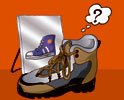When I arrived at Boy Scout backpacking camp at the end of summer, the entrance to our ranch in the New Mexico Rocky Mountains was decorated with dozens of dusty hiking boots dangling from their shoestrings.
"They bought the cheap boots,'' my scoutmaster said as our bus pulled into the camp, many decades ago—cracking wise.
Indeed, it's hard to imagine most hikers discarding their boots in such a cavalier manner. Boots are our security blankets, a vital utilitarian tool and at times our only companions. Worn, dusty boots symbolize trails crossed, mountains climbed and challenges met. We branded ours—like horses—with our troop number. (We weren't wearing them when the scoutmaster branded them.)
Resting in my closet at home, my old boots silently call me back to the outdoors.
The problem with these boots, though, is that they weigh about a million pounds. Tony Soprano doesn't need to make cement shoes for his enemies—just lace these lugs on and toss the body into the East River.
I bought my current pair of leather Vasque boots in 1986, when hiking boots were still a slight step down from heavy European mountain-climbing boots.
Today's "boots", it seems, are a mere step up from high-tech running shoes. They are lighter and less expensive, and increasingly, they are designed less for long, heavy hauls and more for day hikes.
"It used to be people liked the look and feel of a big boot,'' said Dave Edmondson, boot and gear buyer for Buffalo Peak Outdoors. "Now, with the outdoor lifestyle becoming very popular, people do multiple things: hike for a few days, raft for one, fly fish for another. So it has become footwear that does everything."
Ray Jardine, the godfather of ultra-light backpacking, even recommends solid running shoes over boots. His theory is that they dry more quickly, require less energy to hike in and allow you to move with greater speed.
Jardine, though, is carrying an 8-pound pack. Heavier loads require more stability and—especially—more support in the arches of your feet. Lugging a 20- to 30-pound backpack down a 1,400-foot descent puts tremendous pressure on your feet. Your foot will slide forward in the boot, and your arch will be suddenly supporting far more weight (compounded by the jarring compression of hiking) at odder angles than it does when you're strolling in the neighborhood.
Today's outdoor footwear is greatly influenced by trail-runners: running shoes designed specifically for jogging on the open wilderness trails of the West. They can be high on the ankle or not. Turn them over, and you will see a variety of gripping treads, with angles and designs that suggest engineering overkill.
Some are made of Gore-tex—that breathable material that supposedly lets moisture from sweat escape while keeping out moisture from the atmosphere. They have trendy, sporty good looks.
Choosing the right boot is about trade-offs. "Can you hike the Appalachian Trail in a trail shoe? Sure. Are you increasing the chance of injury? Yes,'' Edmonson says.
The good news is that trail shoes are reasonably affordable, with good footwear ranging between $80 and $190—about the same retail price of the boots I purchased in the 1980s. Adjusted for inflation, they are far less expensive today.
The wrong footwear can make a trek challenging, if not miserable.
One friend of mine bought boots on the cheap before our nine-day canoe trek through the Boundary Waters of Minnesota, and the soles were sucked off as he retracted his foot from a muddy bog. It was a thank-God-for-duct-tape moment.
Edmonson recommends working with knowledgeable salespeople who will listen to what your likely uses are: day hikes, cross-country backpacking or something in between. The salespeople should know how much flexibility you need.
Try on multiple boots, even if the first pair feels great, preferably with the socks you are likely to wear. Try them on the incline board or some other non-level surface. Then after buying them, wear them indoors for several hours, just in case you need to return or exchange them.
And, by the way, don't forget socks. Good socks keep your feet dry and warm but not hot. Increasingly, experts are recommending a single, thicker pair rather than the old standby of one internal thin and one external thick. Wool or wool-synthetic blends that wick moisture away from your foot are far superior to cotton.


